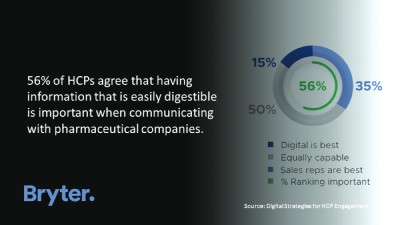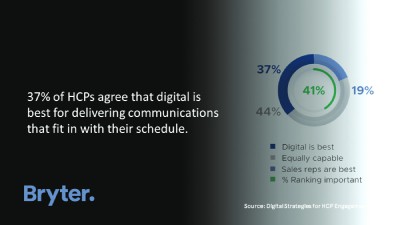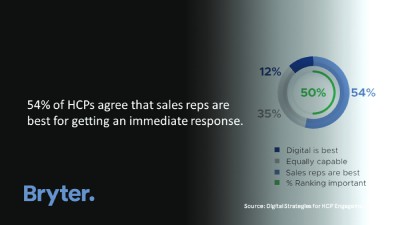
Pharmaceutical marketing strategies across Europe have shifted considerably over recent years. Rapid developments in technology and digital communication, changes in healthcare professional attitudes to salesforce visits, the integration of digital technology into physicians’ daily lives, and drug patent expiry have all played a role over the years. As we find ourselves facing unprecedented times with the outbreak of COVID-19, the need for social distancing and new ways of working mean there is no doubt that physicians will find themselves facing increasing pressures in the months ahead. The pandemic also poses an obvious threat to the face-to-face nature of being a sales rep, and as a result we are likely to see this time act as a catalyst for moving the sales force into digital spaces. Now more than ever, reps will be reliant on making use of existing online channels for virtual contact and adopting remote engagement strategies with physicians.
In the quest for effective marketing strategies there is a clear need for pharmaceutical companies to provide information that is straightforward and easy for physicians to understand. Physicians value qualities such as interactivity, personalised content and information that they do not have to seek out. These experiences come hand-in-hand with sales rep face-to-face communication. Currently, only a small minority of physicians believe digital can do all this.
At the same time, over 70% of doctors in Europe agree that they could not do their job without digital technology and information. When making decisions, physicians spend twice as much time searching for information online (smartphones, laptops or tablets) than in print materials. More than 70% of physicians in the Netherlands and Sweden write prescriptions electronically, and 81% of healthcare professionals use their smartphones for professional purposes, with two-thirds checking them more than ten times a day.
Online conferences and presentations are also growing in clinician popularity due to the lockdown caused by the coronavirus, leading to widespread cancellation and postponement of medical education events, and previously a lack of time available to attend in person. As a result, mobile apps, such as Lexicomp, UpToDate and Halo, are becoming increasingly popular.

In response to this changing landscape, the role of digital marketing to physicians is increasingly essential. With growing difficulty in securing face-to-face visits with healthcare professionals, the pharmaceutical industry is responding with the increased use of digital platforms, yet Europe still lags behind the US and Japan in the uptake of digital marketing – the volume share of digital promotional activity is just 11% compared with 21% in the US and 47% in Japan.
A better understanding of physician preferences can allow pharma marketing efforts to be shaped according to their changing needs. Bryter recently surveyed +1500 physicians across Europe to identify the most critical factors when communicating with pharmaceutical companies. Most valued by physicians was content that was easily digestible and receiving an immediate response to their questions, followed by communications that fit in with their schedule.

Most importantly, all physicians want this process to be as effortless as possible, with information that is both easily accessible and easy to understand.
With current projections suggesting an increasingly digitalised landscape, optimising the use of digital engagement approaches requires an understanding of how digital media compares with physicians’ experiences of sales reps. To address this, Bryter researched how different formats compare with each other and found that the majority of physicians are neutral – feeling that both reps and digital are equally able to communicate these types of information. Physicians remain unconvinced of the ability of digital channels to not only provide them with the same support that reps offer them, but to enhance their interaction with pharmaceutical companies.
Some markets present a more significant challenge. In Belgium, there is a greater reliance on face-to-face meetings with sales reps, whereas, in the UK and France, physicians are generally more open to digital communications.
A third of physicians believe sales reps are better at providing information that is easily digestible vs 15% of physicians who believe that digital is best. Half had no strong beliefs either way. France and the UK show the most optimism towards digital strategies, whereas Switzerland and Belgium have either no preference or favour reps.
With the exception of France, at least half of physicians across all markets believe that reps are better equipped than digital to answer their questions immediately.
There was widespread recognition, however, that digital fits in better with physician schedules than sales visits.
So, how can pharmaceutical companies take advantage of digital strategies to evolve their sales approach? Pharmaceutical companies need to adapt their approach in this changing landscape. Digital cannot replace sales representatives – nor does it need to. Multichannel engagement provides the opportunity to bridge the gap between the increasingly infrequent and sparse face-to-face visits with the convenience and flexibility of digital.
Digital channels can be used for real-time communication with physicians even more regularly than periodic face-to-face visits. E-detailing is already an established means of allowing efficient engagement, interactivity and convenience at a lower cost.
Digital marketing materials can be used to offer interactive and engaging content, helping to ensure pharmaceutical companies maintain a connection with and awareness among physicians when it suits their schedules. Content can be optimised, updated and tailored to remain relevant to physicians.
Pharmaceutical companies must have in-depth knowledge of how they should be communicating and connecting with physicians. By gaining a greater understanding of physician attitudes, behaviours, motivators, prescribing habits and preferred information channels through market research, pharmaceutical companies can allow their sales reps to deliver an optimal customer experience tailored to physician and market needs.
If used in the right way, digital strategies can keep reps connected with physicians more closely than ever. The challenge is in proving to physicians that digital can provide them with the same support that sales reps offer. This is critical as it remains unclear how long social distancing measures will be necessary, and to what extent normal life will be resumed.

It seems increasingly unlikely that everything will simply return to the previous status quo, as industries are thrust into the digital space. It is likely that both primary and secondary care will want to keep onsite interactions restricted to an essential basis only to maintain the safety of patients and healthcare professionals as far as possible. Instead, this is likely to be a turning point for pharma to embrace digital marketing as the industry is faced with the choice to sink or swim.
Pharmaceutical marketing teams looking for further information can download Bryter’s ‘Digital Marketing to Doctors’ report at https://pages.bryterresearch.co.uk/download-digital-strategies-for-hcpengagement
Laurence Olding is a Healthcare Research Manager and Georgina James is a Research Executive, both at Bryter




